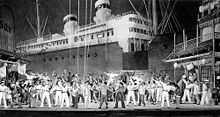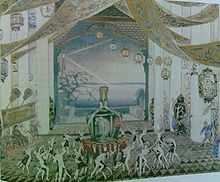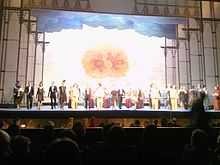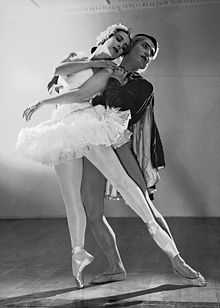The Red Poppy
| The Red Poppy | |
|---|---|
|
Scene from The Red Poppy, a drawing on a Soviet postage stamp | |
| Native title | Красный мак |
| Choreographer |
(Acts 1 & 3): Lev Lashchilin (Act 2): Vasily Tikhomirov |
| Music | Reinhold Glière |
| Premiere |
14 June 1927 Bolshoi Theatre, Moscow, Soviet Union |
| Original ballet company | Bolshoi Ballet |
| Characters |
Tao-Hoa Soviet Captain Li Shan-fu Chinese prestidigitator Harbormaster Ma Lichen (1949 staging) Nüwa (2010 staging) |
| Design | Mikhail Kurilko |
| Setting | 1920s-era Kuomintang China |
The Red Poppy (Russian: Красный мак) or sometimes The Red Flower (Russian: Красный цветок) is a ballet in three acts and an apotheosis, with a score written by Reinhold Glière and scenario by Mikhail Kurilko. This ballet was created in 1927 as the first Soviet ballet with a modern revolutionary theme. Possibly the most famous dance from this ballet is the Sailors Dance, sometimes referred to as the "Russian Sailors Dance." It is this musical selection for which Glière is perhaps best known. There have been four main versions of The Red Poppy.
History
Original version (1927)

The original version of The Red Poppy was choreographed by Lev Lashchilin (1st and 3rd Acts) and Vasily Tikhomirov (2nd Act). The first performance was on 14 June 1927 in the Bolshoi Theatre.
This production was staged in 1928 and 1930 in Sverdlovsk, and in 1928, 1949, and 1958 in Saratov. The Leningradsky Theatre of opera and ballet staged the ballet in in 1929 in Leningrad. The original version was performed in 1941 and 1950 in Gorki; in 1946 in Baku by the Azerbaijan State Academic Opera and Ballet Theatre; and in 1949 and 1958 by the Kirov Ballet.
In 1943, the Ballet Russe de Monte Carlo staged a one-act version of the ballet in the Public Music Hall, Cleveland, Ohio.[1] Premiering on October 9, 1943, the production was staged by Igor Schwezoff, with decor by Boris Aronson. With World War II in full swing (and the Soviets and Americans being allies), the evil Li Shan-Fu was changed to a Japanese bar owner, and the group of Russian dancers was made to include British and Americans as well.[2]

The Red Flower (1957)
In 1957, Vasily Tikhomirov and Mikhail Kurilko staged an expanded version of the ballet. Renamed The Red Flower (to avoid the association with opium), the number of scenes was increased from 8 to 13. It was first performed on 24 November 1957 in the Bolshoi Theatre.
Lavrovsky version (1949)
In 1949 a new version of The Red Poppy was choreographed by Leonid Lavrovsky.[3] The scenario was rewritten by Aleksey Yermolayev, and the ballet was first performed on 30 December 1949 in the Bolshoi Theatre.[3] The 1949 version introduced a new character, Ma Lichen.
Androsov version (2010)

On 12 February 2010, a new production of The Red Poppy, with choreography by Nikolay Androsov, was performed at Teatro dell'Opera di Roma. Scenery and costumes by Elena Puliti, conductor Andre Anichanov, musical cooperation from Francesco Sodini, and director of production Beppe Menegatti. This version introduced a new character, Nüwa, goddess of fertility. A new production of this version is expected on June 13, 2015, at the Rostov State Opera and Ballet (Musical) Theatre, in Rostov-on-Don.
Vasiliev version (2010)
Also in 2010, a new production choreographed by Vladimir Vasiliev (who also did scenario editing and scenery), with costumes by Maria Vol'skaya, and music director and conducting by Anatoly Chepurnoy, was performed on 23 November at the Krasnoyarsk Ballet and Opera Theater.
Other performances
- 1949 in Perm
- 1950 and 1961 in Kuybyshev
- 1950 in Novosibirsk
- 1954 in Bratislava, Slovak National Theatre
- 1962 in Volgograd
Synopsis
The ballet takes place at a seaport in 1920s-era Kuomintang China. A ship carrying sailors from many lands, including Russia is docked in a Chinese seaport. The captain notices a group of half-starved, overworked coolies being brutally driven to work even harder by their cruel harbormaster.
One night while dancing for the sailors aboard the ship, the beautiful Tao-Hoa (Pinyin: Taohua) notices a Russian captain trying to rescue the poor Coolies from the port commander. Impressed by the captain's act of kindness she gives him a red poppy as a symbol of her love.
When Tao's employer, Li Shan-Fu learns of this, he is jealous and orders her to kill the captain. She refuses, and is later killed by her employer when a riot breaks out on the dock — thus sacrificing her life for the captain. As she dies, she gives another red poppy flower to a young Chinese girl as a sign of love and freedom.
Structure
Act One
- Introduction
- Coolies' Dance
- Tao-Hoa's Entrance
- Restaurant Scene
- Malik's Dance
- Boston Waltz
- Scene of European Dance
- Captain's Entrance and Sailors Dance
- Tao-Hoa's Scene
- Variation with Gold Fingers
- Coolies' Victory Dance
- Dance of the Soviet Sailors: Apple
Act Two
- Introduction - Scene in the Smoking Room
- Scene
- Dance of the Chinese Women
- Adagio of Four Goddesses
- Adagio
- Prelude
- Tao-Hoa's Vision
- Procession Scene
- Sword Dance
- Phoenix
- Adagio
- The Rose Ship
Act Three
- Charleston
- Dance in the Restaurant
- Preparation of the Chinese Theatre
- Umbrella Dance
- Puppet Dance
- Chinese Acrobats' Dance
- The Conspiracy
- Scene of Confusion
- Captain's Scene
- Tao-Hoa's Scene: The Departing Ship
- Rebellion Scene
- Death of Tao-Hoa
Characters
- Tao-Hoa — Yekaterina Geltzer (1927), Viktorina Kriger (1927), Galina Ulanova (1949 and 1957), Olga Lepeshinskaya (1949), Alexandra Danilova (1943), Oksana Kucheruk (2010), Gaia Straccamore (2010), Anna Ol (2010)
- Soviet Captain — Alexey Bulgakov and Mikhail Dudko (1927), Alexander Radunsky (1949 and 1957), Frederic Franklin (1943), Lukash Abrahamyan (2007), Igor Yebra (2010), Vito Mazzeo (2010), Vyacheslav Kapustin (2010)
- Ma Lichen, introduced in the staging of 1949 — Yury Kondratov (1949 and 1957), Mikhail Gabovich (1949), Damiano Mongelli (2010)
- Li Shan-fu — Ivan Smoltsov (1927), Sergey Koren (1949 and 1957), Alexey Yermolayev (1949), Vito Mazzeo (2010), Manuel Paruccini (2010), Ivan Karnaukhov (2010)), Farukh Ruzimatov (2015)
- Nüwa, goddess of fertility, introduced in the staging of 2010 — Carla Fracci
- Chinese prestidigitator — Asaf Messerer (1927)
- Harbormaster — Ivan Sidorov (1927), Alexei Bal'va (2010)
References
- ↑ "The Red Poppy: The Ballet Russe Collection," Butler University Department of Dance. Accessed Feb. 14. 2015.
- ↑ Anderson, Jack. The One and Only: The Ballet Russe de Monte Carlo, Dance Books Ltd (2010).
- ↑ 3.0 3.1 Koegler, Horst. The Concise Oxford Dictionary of Ballet, 2nd edition. Oxford University Press (1982).
External links
- Film-ballet The Red Poppy produced by Czechoslovak TV in 1955, filmed in Studio Bratislava after performance of the Slovak National Theatre, choreography: R. Tomskij, Bolshoi Theatre Moscow)
- Rome Opera Theater's webpage on the ballet
- Pictures from 2010 Italian production
- Video clip from 2010 Italian production
- Short video clip from 2010 Italian production
- Russian Radio report on the Krasnoyarsk 2010 production
| ||||||||||||||||||||||||||||||||||||
